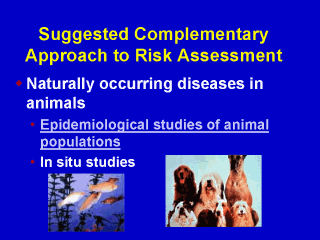|
|
|
|
front |1 |2 |3 |4 |5 |6 |7 |8 |9 |10 |11 |12 |13 |14 |15 |16 |17 |18 |19 |20 |21 |22 |23 |24 |review |
 |
1) Descriptive epidemiology can to used to characterize the frequency and patterns of disease in animal populations and identify possible associations with environmental exposures. 2) Analytic epidemiology can be used to test hypotheses of environmental exposure-disease relationships in animals using controlled-observational methods. 3) In situ studies involve the placement of sentinel animals at a site where environmental contamination is suspected. The animals are monitored under controlled conditions to assess any health effects. In situ studies have long been used to test for the presence of certain infectious organisms in the environment. For example, sentinel chickens are strategically placed and monitored by regular blood tests for the development of antibodies to viruses that cause encephalitis in people. Detection of such antibodies prompts immediate mosquito control measures and public health education efforts. |